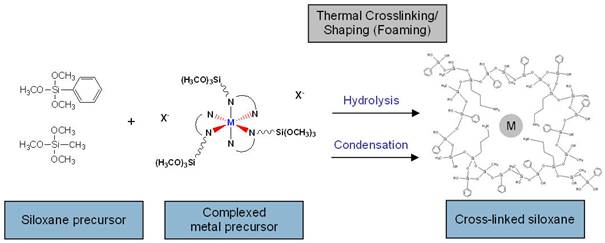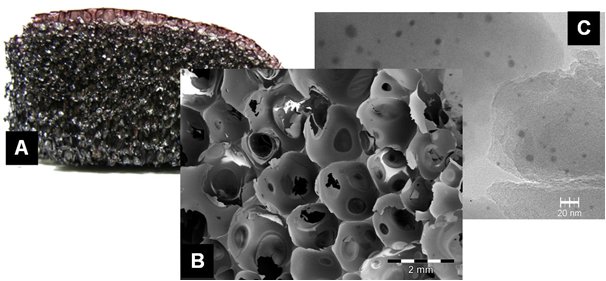Precursor derived ceramics - Ceramers
The conversion of polymeric precursors under an atmosphere of inert gas at moderate temperatures is a versatile processing route for non-oxidic ceramic materials such as SiC, Si3N4 or SiOC as compared to the much more energy consuming conventional sintering of SiC or Si3N4 powders. Generally the starting materials are inexpensive and can easily be processed using well-established shaping methods used for the processing of polymers. By varying the precursor composition or the temperature regime of pyrolysis or by addition of filler particles hybrid materials and advanced ceramics with interesting properties can be obtained. Porous or dense microstructures, high temperature, oxidation and chemical resistance or magnetic and electroconducting behaviour can be provided and engineered for different applications. The purification of exhaust gas using adsorbents is an important demand to reduce the global air pollution. By converting polysiloxane precursors partly into hybrid materials (Ceramers) with high specific surface areas, tuneable pore size distributions and adjustable surface characteristics can be obtained, which are the main requirements to provide new adsorbents with a high cleaning efficiency. One of the key issues is the specific modification of the surfaces by changing the chemical nature of the precursor and thereby the remaining surface groups that will influence the selective interaction with the adsorptive. The investigation and efficient use of surface-substrate interactions are of even higher demand for the development of porous heterogeneous catalysts due to the more complex reaction pathway on the surface of a metallic active site. With the manufacturing of hierarchical ordered foamed or particle hybrid materials containing in-situ generated metallic nanoparticles some drawbacks of conventional supported catalyst are expected to be overcome. For instance, the long-term stability should be increased due to a stronger particle-matrix interaction that avoids extensive sintering of the metal at higher operation temperatures. At the same time, the adjusted porosity should provide a good accessibility of the catalyst particles and a fast heat and mass transfer leading to a controlled catalysed reaction with an increased selectivity towards the desired product. The supply of new materials for a sustainable power generation is one of the most urgent aims of the new century addressing the ebbing of fossil fuels. High-temperature polymer electrolyte fuel cells are discussed to be a promising, resource-saving technology. However, this technology requires proton conducting and temperature resistant (200°C) polymers, which are rare among organic materials. Functionalised and just cross-linked polysiloxanes exhibit these properties and could therefore substitute conventional proton conductors. High conductivities are generally reached for materials using a water based conduction mechanism, which collapses, however, at higher operation temperatures due to the evaporation of water. Functionalised polysiloxanes with organic groups transferring the protons without the help of water are promising candidates to solve this problem. An extension of this development is the production of membrane-electrode-assemblies using electroconducting hybrid materials also based on polysiloxanes as electrocatalyst which are expected to show an improved interaction at the three phase boundary of these novel fuel cell materials.






